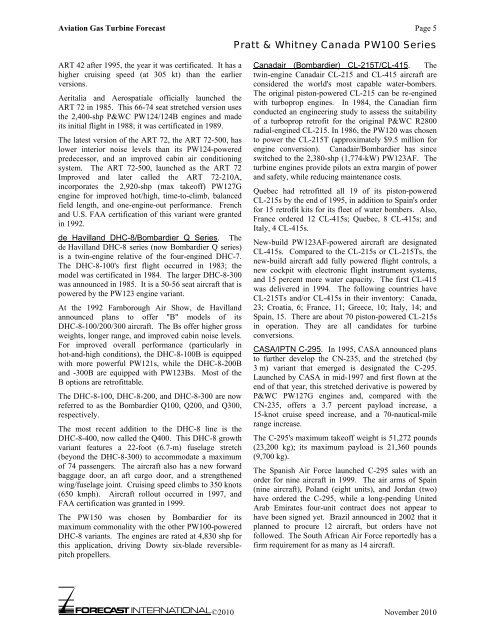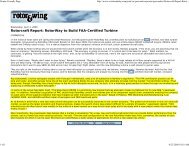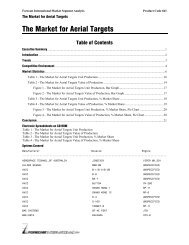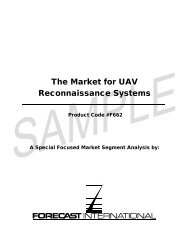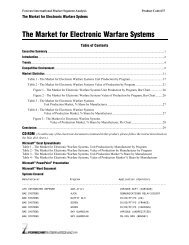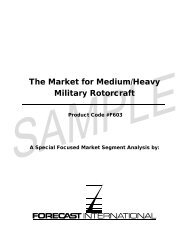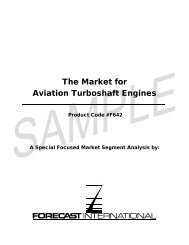The Market for Aviation Turboprop Engines - Forecast International
The Market for Aviation Turboprop Engines - Forecast International
The Market for Aviation Turboprop Engines - Forecast International
Create successful ePaper yourself
Turn your PDF publications into a flip-book with our unique Google optimized e-Paper software.
<strong>Aviation</strong> Gas Turbine <strong>Forecast</strong> Page 5<br />
Pratt & Whitney Canada PW100 Series<br />
ART 42 after 1995, the year it was certificated. It has a<br />
higher cruising speed (at 305 kt) than the earlier<br />
versions.<br />
Aeritalia and Aerospatiale officially launched the<br />
ART 72 in 1985. This 66-74 seat stretched version uses<br />
the 2,400-shp P&WC PW124/124B engines and made<br />
its initial flight in 1988; it was certificated in 1989.<br />
<strong>The</strong> latest version of the ART 72, the ART 72-500, has<br />
lower interior noise levels than its PW124-powered<br />
predecessor, and an improved cabin air conditioning<br />
system. <strong>The</strong> ART 72-500, launched as the ART 72<br />
Improved and later called the ART 72-210A,<br />
incorporates the 2,920-shp (max takeoff) PW127G<br />
engine <strong>for</strong> improved hot/high, time-to-climb, balanced<br />
field length, and one-engine-out per<strong>for</strong>mance. French<br />
and U.S. FAA certification of this variant were granted<br />
in 1992.<br />
de Havilland DHC-8/Bombardier Q Series. <strong>The</strong><br />
de Havilland DHC-8 series (now Bombardier Q series)<br />
is a twin-engine relative of the four-engined DHC-7.<br />
<strong>The</strong> DHC-8-100's first flight occurred in 1983; the<br />
model was certificated in 1984. <strong>The</strong> larger DHC-8-300<br />
was announced in 1985. It is a 50-56 seat aircraft that is<br />
powered by the PW123 engine variant.<br />
At the 1992 Farnborough Air Show, de Havilland<br />
announced plans to offer "B" models of its<br />
DHC-8-100/200/300 aircraft. <strong>The</strong> Bs offer higher gross<br />
weights, longer range, and improved cabin noise levels.<br />
For improved overall per<strong>for</strong>mance (particularly in<br />
hot-and-high conditions), the DHC-8-100B is equipped<br />
with more powerful PW121s, while the DHC-8-200B<br />
and -300B are equipped with PW123Bs. Most of the<br />
B options are retrofittable.<br />
<strong>The</strong> DHC-8-100, DHC-8-200, and DHC-8-300 are now<br />
referred to as the Bombardier Q100, Q200, and Q300,<br />
respectively.<br />
<strong>The</strong> most recent addition to the DHC-8 line is the<br />
DHC-8-400, now called the Q400. This DHC-8 growth<br />
variant features a 22-foot (6.7-m) fuselage stretch<br />
(beyond the DHC-8-300) to accommodate a maximum<br />
of 74 passengers. <strong>The</strong> aircraft also has a new <strong>for</strong>ward<br />
baggage door, an aft cargo door, and a strengthened<br />
wing/fuselage joint. Cruising speed climbs to 350 knots<br />
(650 kmph). Aircraft rollout occurred in 1997, and<br />
FAA certification was granted in 1999.<br />
<strong>The</strong> PW150 was chosen by Bombardier <strong>for</strong> its<br />
maximum commonality with the other PW100-powered<br />
DHC-8 variants. <strong>The</strong> engines are rated at 4,830 shp <strong>for</strong><br />
this application, driving Dowty six-blade reversiblepitch<br />
propellers.<br />
Canadair (Bombardier) CL-215T/CL-415. <strong>The</strong><br />
twin-engine Canadair CL-215 and CL-415 aircraft are<br />
considered the world's most capable water-bombers.<br />
<strong>The</strong> original piston-powered CL-215 can be re-engined<br />
with turboprop engines. In 1984, the Canadian firm<br />
conducted an engineering study to assess the suitability<br />
of a turboprop retrofit <strong>for</strong> the original P&WC R2800<br />
radial-engined CL-215. In 1986, the PW120 was chosen<br />
to power the CL-215T (approximately $9.5 million <strong>for</strong><br />
engine conversion). Canadair/Bombardier has since<br />
switched to the 2,380-shp (1,774-kW) PW123AF. <strong>The</strong><br />
turbine engines provide pilots an extra margin of power<br />
and safety, while reducing maintenance costs.<br />
Quebec had retrofitted all 19 of its piston-powered<br />
CL-215s by the end of 1995, in addition to Spain's order<br />
<strong>for</strong> 15 retrofit kits <strong>for</strong> its fleet of water bombers. Also,<br />
France ordered 12 CL-415s; Quebec, 8 CL-415s; and<br />
Italy, 4 CL-415s.<br />
New-build PW123AF-powered aircraft are designated<br />
CL-415s. Compared to the CL-215s or CL-215Ts, the<br />
new-build aircraft add fully powered flight controls, a<br />
new cockpit with electronic flight instrument systems,<br />
and 15 percent more water capacity. <strong>The</strong> first CL-415<br />
was delivered in 1994. <strong>The</strong> following countries have<br />
CL-215Ts and/or CL-415s in their inventory: Canada,<br />
23; Croatia, 6; France, 11; Greece, 10; Italy, 14; and<br />
Spain, 15. <strong>The</strong>re are about 70 piston-powered CL-215s<br />
in operation. <strong>The</strong>y are all candidates <strong>for</strong> turbine<br />
conversions.<br />
CASA/IPTN C-295. In 1995, CASA announced plans<br />
to further develop the CN-235, and the stretched (by<br />
3 m) variant that emerged is designated the C-295.<br />
Launched by CASA in mid-1997 and first flown at the<br />
end of that year, this stretched derivative is powered by<br />
P&WC PW127G engines and, compared with the<br />
CN-235, offers a 3.7 percent payload increase, a<br />
15-knot cruise speed increase, and a 70-nautical-mile<br />
range increase.<br />
<strong>The</strong> C-295's maximum takeoff weight is 51,272 pounds<br />
(23,200 kg); its maximum payload is 21,360 pounds<br />
(9,700 kg).<br />
<strong>The</strong> Spanish Air Force launched C-295 sales with an<br />
order <strong>for</strong> nine aircraft in 1999. <strong>The</strong> air arms of Spain<br />
(nine aircraft), Poland (eight units), and Jordan (two)<br />
have ordered the C-295, while a long-pending United<br />
Arab Emirates four-unit contract does not appear to<br />
have been signed yet. Brazil announced in 2002 that it<br />
planned to procure 12 aircraft, but orders have not<br />
followed. <strong>The</strong> South African Air Force reportedly has a<br />
firm requirement <strong>for</strong> as many as 14 aircraft.<br />
©2010 November 2010


